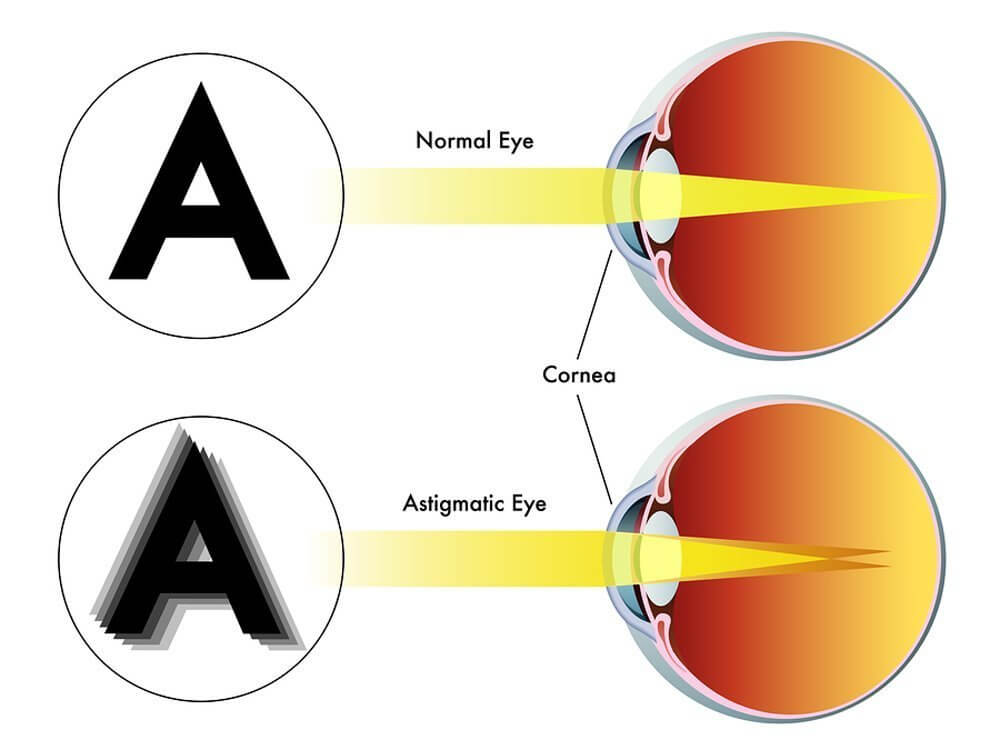Astigmatism
Posted by: Invision Optometry in Category Astigmatism

Astigmatism is a common vision condition that causes blurred vision. Like nearsightedness and farsightedness, astigmatism is a refractive error. It is not an eye disease or an eye problem, but rather a condition in which the eye does not focus light precisely on the retina (the light-sensitive tissue at the back of the eye). Characterized by an irregular curvature of the cornea, astigmatism usually is present at birth. In an eye with astigmatism, the curvature of the cornea (and lens) bends the light entering the eye differently, resulting in distorted or blurred vision at all distances. The truth is, most eyes are not perfect. Whether you have mild or severe astigmatism, it is completely normal.
Most People Are Born With Astigmatism…
What Causes Astigmatism?
Usually, an irregular-shaped cornea, the clear front surface of the eye, causes astigmatism. In astigmatism, the cornea is not perfectly round, but rather football shaped. This distorts the light entering the eye, which does not focus correctly on the retina, and as a result, the image is blurred. Most people are born with it, but the specific cause is unknown. There are two types of astigmatism. Regular astigmatism is when the cornea is curved more in one direction than the other. Irregular astigmatism is far less common, and occurs when the curvature of the cornea is not even. This type of astigmatism may be the result of an eye injury and related damage to the cornea, or a condition such as keratoconus.
A Common Symptom Is Blurred Vision…

Astigmatism Signs and Symptoms
Headaches, eye strain, squinting, distorted or blurry vision at all distances and difficulties driving at night are all common symptoms associated with astigmatism. Some people can even have a small amount of astigmatism, but not notice it at all. This is especially true for children who may be unaware that is not normal. Some people may also have astigmatism without symptoms. To find out if you have astigmatism, schedule an annual comprehensive eye exam with your eyecare provider. Because children may not realize their vision is blurry, they need to be screened for eye disease and have their vision tested by an optometrist every year. If you or your child have experienced any symptoms, contact your eye doctor. Your doctor can determine whether you have astigmatism during your exam and, if so, to what degree. Once you have been diagnosed, he or she can then advise you of your options to correct your vision.
It Is Possible To Have Mild Astigmatism And Not Know It…
How is Astigmatism Corrected?
In most cases, astigmatism can be corrected with glasses, contacts, orthokeratology, or LASIK(refractive surgery). Most individuals choose glasses to correct their vision, that contain a special cylindrical lens prescription to compensate for the astigmatism. So, in addition to the spherical lens power used to correct myopia or hyperopia, astigmatism requires an additional cylinder lens power to correct the difference between the powers of the two principal meridians of the eye.
When You Have Astigmatism, Different Meridians Of Your Eye Need Different Amounts Of Correction For Nearsightedness Or Farsightedness…
Contact Lenses For Astigmatism
In many cases, contact lenses provide a clearer, wider field of vision and greater comfort. They are a safe and effective option if fitted and used properly. However, contact lenses are not right for everyone. Rigid gas permeable contact lenses often provide the best correction for astigmatism. But special soft contact lenses for astigmatism, called toric soft lenses, are also available. Hybrid contact lenses are another option. These lenses have a gas permeable center and a soft periphery to provide the clarity of a gas permeable lens and wearing comfort of a soft lens.
Toric Contacts Have Different Powers In Different Meridians Of The Lens To Correct Variations In The Eye’s Shape…
Orthokeratology
Orthokeratology is a non-surgical procedure that involves the wearing of a series of specially designed rigid contact lenses to progressively reshape the curvature of the cornea over time. The results of this painless procedure are not permanent; thus, retainer contact lenses must be worn periodically to maintain improvements made in vision. It is used to treat low to moderate nearsightedness and low degrees of astigmatism.
Orthokeratology Is Used To Treat Low Degrees Of Astigmatism…
Custom LASIK
Depending on the type and severity of your astigmatism, you may also have it corrected with LASIK or other types of refractive surgery. Custom LASIK(also known as wavefront-guided LASIK) utilizes guided technology to precisely measure how light focuses on the back of the eye. A femtosecond laser is used to create a corneal “flap” which allows for a very rapid recovery in vision. The excimer laser is then used to correct subtle visual imperfections while reshaping the cornea, reducing the amount of near-sightedness, farsightedness or astigmatism.
Depending On The Type And Severity Of Your Astigmatism, You May Also Have It Corrected With LASIK…
Vision Correction
Whatever your vision challenge, the good news is many vision problems can be corrected. Our team of highly trained eye doctors will listen to your concerns and accommodate your unique vision needs. During a comprehensive eye exam, we will help you determine which option or procedure is right for you. If you are experiencing any vision difficulties, schedule an appointment, or call us at (619) 222-2020 to see how we can help.


